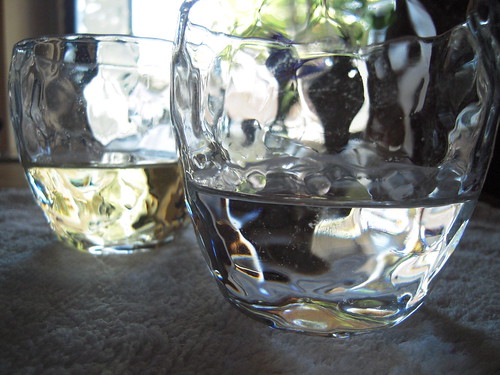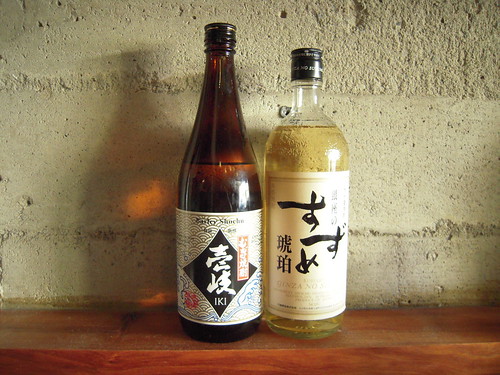
This time I would like to talk about m
ugi (barley) shochu in more general terms.
Mugi
shochu might be easier to understand than any other shochu, because mugi shochu is distilled from barley--like whisky, vodka, and gin. There are two types of
mugi shochus. One is clear, and the other is amber. The amber one is aged in oak barrels, and the taste is like light whisky. So what is the difference between aged
mugi shochu and whisky?
First, shochu's ABV is about 25%, whereas whisky is about 40%. Secondly, the appearance of shochu is regulated by the Japanese government. By law, the color of mugi shochu must be 90% lighter than whisky. Interesting, right?
But the biggest difference is the ingredient for fermentation. The fermentation ingredient for whisky is malted barley, while the fermentation ingredient for shochu is
koji. Koji is mold from steamed rice, and is used to make all kinds of shochu and sake.
Let me compare non-aged mugi shochu
Iki and aged mugi shochu
Ginza no Suzume Kohaku.
 Iki
Iki is a non-aged mugi shochu made on Iki Island, in the Nagasaki prefecture of Japan. Mugi shochu is said to have originated on Iki. Mugi shochu is made on Iki islands have been given protection under WTO regulations as a geographical indication (like Champagne).
Meanwhile,
Ginza no Suzume Kohaku is aged mugi shochu made in the Oita prefecture in Japan where is also famous for mugi shochu. Iichiko and Nikakido, two shochus that I mentioned in my
first post, are also made in Oita.
The color of
Iki is clear, while the color of
Ginza is amber, as it is aged.

The aroma of
Iki is that of grain, while the aroma of
Ginza is caramel and woody. The taste of
Iki is mild, clean, with a hint of pear; while the taste of Ginza is sweet, smoky, and caramel.
Think of an unaged shochu to be like a tequila blanco, and the aged to be more like a reposado, in color and in flavor dimensions.
Simply speaking, non-aged mugi shochu is cleaner, and aged mugi shochu is sweeter and tastes like whisky. Non-aged shochus goes well with fish food and fried food like tempura, while the aged varieties pairs well with cheese, smoked food, and meats.
This post was too intense to write! I'm exhausted, man. I couldn't insert any jokes. I want to write next post more fun and drunk. See you soon!
Shochu doesn't cheat you. Shochu always stands by you. Take your shochu time.
 This time I would like to talk about mugi (barley) shochu in more general terms.
Mugi shochu might be easier to understand than any other shochu, because mugi shochu is distilled from barley--like whisky, vodka, and gin. There are two types of mugi shochus. One is clear, and the other is amber. The amber one is aged in oak barrels, and the taste is like light whisky. So what is the difference between aged mugi shochu and whisky?
First, shochu's ABV is about 25%, whereas whisky is about 40%. Secondly, the appearance of shochu is regulated by the Japanese government. By law, the color of mugi shochu must be 90% lighter than whisky. Interesting, right?
But the biggest difference is the ingredient for fermentation. The fermentation ingredient for whisky is malted barley, while the fermentation ingredient for shochu is koji. Koji is mold from steamed rice, and is used to make all kinds of shochu and sake.
Let me compare non-aged mugi shochu Iki and aged mugi shochu Ginza no Suzume Kohaku.
This time I would like to talk about mugi (barley) shochu in more general terms.
Mugi shochu might be easier to understand than any other shochu, because mugi shochu is distilled from barley--like whisky, vodka, and gin. There are two types of mugi shochus. One is clear, and the other is amber. The amber one is aged in oak barrels, and the taste is like light whisky. So what is the difference between aged mugi shochu and whisky?
First, shochu's ABV is about 25%, whereas whisky is about 40%. Secondly, the appearance of shochu is regulated by the Japanese government. By law, the color of mugi shochu must be 90% lighter than whisky. Interesting, right?
But the biggest difference is the ingredient for fermentation. The fermentation ingredient for whisky is malted barley, while the fermentation ingredient for shochu is koji. Koji is mold from steamed rice, and is used to make all kinds of shochu and sake.
Let me compare non-aged mugi shochu Iki and aged mugi shochu Ginza no Suzume Kohaku.
 Iki is a non-aged mugi shochu made on Iki Island, in the Nagasaki prefecture of Japan. Mugi shochu is said to have originated on Iki. Mugi shochu is made on Iki islands have been given protection under WTO regulations as a geographical indication (like Champagne).
Meanwhile, Ginza no Suzume Kohaku is aged mugi shochu made in the Oita prefecture in Japan where is also famous for mugi shochu. Iichiko and Nikakido, two shochus that I mentioned in my first post, are also made in Oita.
The color of Iki is clear, while the color of Ginza is amber, as it is aged.
Iki is a non-aged mugi shochu made on Iki Island, in the Nagasaki prefecture of Japan. Mugi shochu is said to have originated on Iki. Mugi shochu is made on Iki islands have been given protection under WTO regulations as a geographical indication (like Champagne).
Meanwhile, Ginza no Suzume Kohaku is aged mugi shochu made in the Oita prefecture in Japan where is also famous for mugi shochu. Iichiko and Nikakido, two shochus that I mentioned in my first post, are also made in Oita.
The color of Iki is clear, while the color of Ginza is amber, as it is aged.
 The aroma of Iki is that of grain, while the aroma of Ginza is caramel and woody. The taste of Iki is mild, clean, with a hint of pear; while the taste of Ginza is sweet, smoky, and caramel.
Think of an unaged shochu to be like a tequila blanco, and the aged to be more like a reposado, in color and in flavor dimensions.
Simply speaking, non-aged mugi shochu is cleaner, and aged mugi shochu is sweeter and tastes like whisky. Non-aged shochus goes well with fish food and fried food like tempura, while the aged varieties pairs well with cheese, smoked food, and meats.
This post was too intense to write! I'm exhausted, man. I couldn't insert any jokes. I want to write next post more fun and drunk. See you soon!
Shochu doesn't cheat you. Shochu always stands by you. Take your shochu time.
The aroma of Iki is that of grain, while the aroma of Ginza is caramel and woody. The taste of Iki is mild, clean, with a hint of pear; while the taste of Ginza is sweet, smoky, and caramel.
Think of an unaged shochu to be like a tequila blanco, and the aged to be more like a reposado, in color and in flavor dimensions.
Simply speaking, non-aged mugi shochu is cleaner, and aged mugi shochu is sweeter and tastes like whisky. Non-aged shochus goes well with fish food and fried food like tempura, while the aged varieties pairs well with cheese, smoked food, and meats.
This post was too intense to write! I'm exhausted, man. I couldn't insert any jokes. I want to write next post more fun and drunk. See you soon!
Shochu doesn't cheat you. Shochu always stands by you. Take your shochu time.




Comments (4)
Man, this post was intense to write! My brain hurts and now I just want to drink shochu, but I don’t have any. I think I will go for a bike ride instead.
Man, this post was intense to read! I learned a lot, though. My brain hurts and now I just want to drink shochu, but I don’t have any. I think I will go for a bike ride instead.
It was awesome article!! Very scientific one!! As a result, my brain hurts too. Where is your joke, man? I am a big fun of your jokes, man.
LIke your blog. Where did you get the cool glasses in the pictures?? Please, I have to know.